HP Elite Folio review: Extreme mobility for a price
The HP Elite Folio wraps vivid display options, 4G/5G connectivity options, and all-day battery life within a lightweight, stylish design. It clearly wins on mobility.
The 2-in-1 laptop’s Qualcomm Snapdragon 8cx Gen 2 5G processor has its caveats, though. Its performance still can’t compete with that of modern AMD Ryzen or Intel Core processors, and software compatibility issues persist. These limitations may be tough to tolerate considering the Elite Folio’s premium price tag.
This review is part of our ongoing roundup of the best laptops. Go there for information on competing products and how we tested them.
HP Elite Folio basic features
HP’s Elite Folio is available in either an 8GB RAM/16GB SSD fixed configuration on HP.com for $1,889, or a configurable Elite Folio option that begins at $1,895.04. It’s worth noting that while the first option appears ready to ship, selecting the configurable option puts the ship date at October 7—with a big qualifier: “This platform has an extended build time. Component availability, and hence the ship date, may change.” A different configuration is $1,949.95 on Amazon.
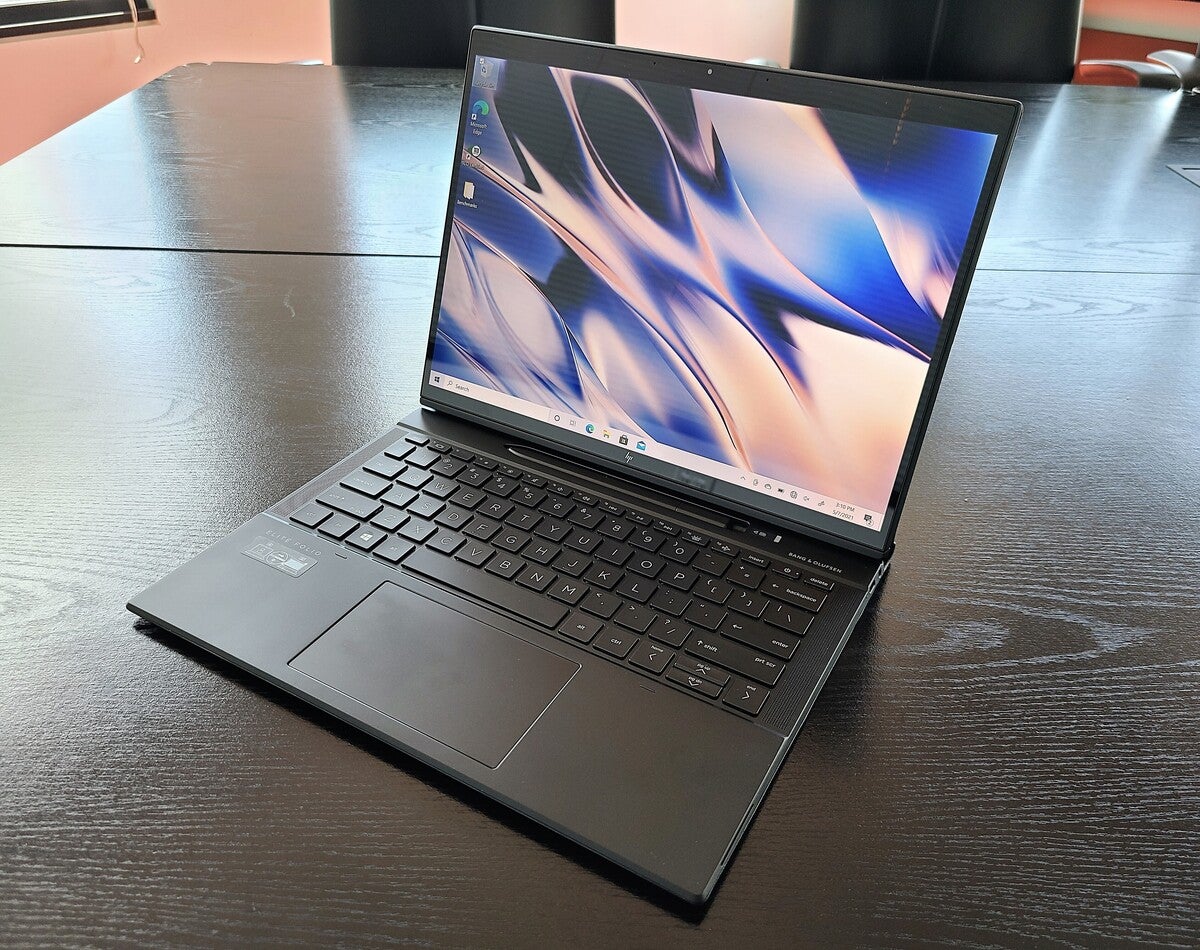 Mark Hachman / IDG
Mark Hachman / IDGHP’s Elite Folio, in its more traditional desktop orientation.
- Processor: Qualcomm Snapdragon 8cx Gen 2 5G
- Display: 13.3-inch (1920×1280) IPS touch, 400 nits rated
- Memory: 8GB/16GB LPDDR4x-4266 (16GB as tested)
- Storage: 128GB/256GB/512GB PCIe NVMe SSD (512GB as tested)
- Graphics: Adreno 690
- Ports: 2 USB-C 5Gbps (DisplayPort 1.4, USB PD)
- Security: Windows Hello
- Camera: 720p (user-facing, Windows Hello)
- Battery: 46Wh (rated); 47.6Wh (as tested)
- Wireless: 8021.11ac (2×2 MIMO), Bluetooth 5, Snapdragon X20 LTE Cat 16
- Operating system: Windows 10 Home/Pro (Windows 10 Home as tested)
- Dimensions: 11.75 x 9.03 x 0.63 inches
- Weight: 2.93 pounds, 3.57 with charger
- Color: Black
While the Elite Folio looks like a clamshell laptop, it’s closer to a 2-in-1 Windows tablet. The keyboard does not detach, as it does with Microsoft’s Surface Pro X or Surface Pro 7+. Instead, it can rotate flat into a tablet mode. A “hybrid” mode allows it to pull forward, hiding the keyboard for streaming video and using the screen as a primary interface.
The Elite Folio’s Qualcomm Snapdragon 8cx Gen 2 5G is an Arm processor that mimics the customized Arm chip used inside the Surface Pro X and the Lenovo Flex 5G. Those tablets, however, used a slightly earlier version of the Snapdragon 8cx, the Gen 1.
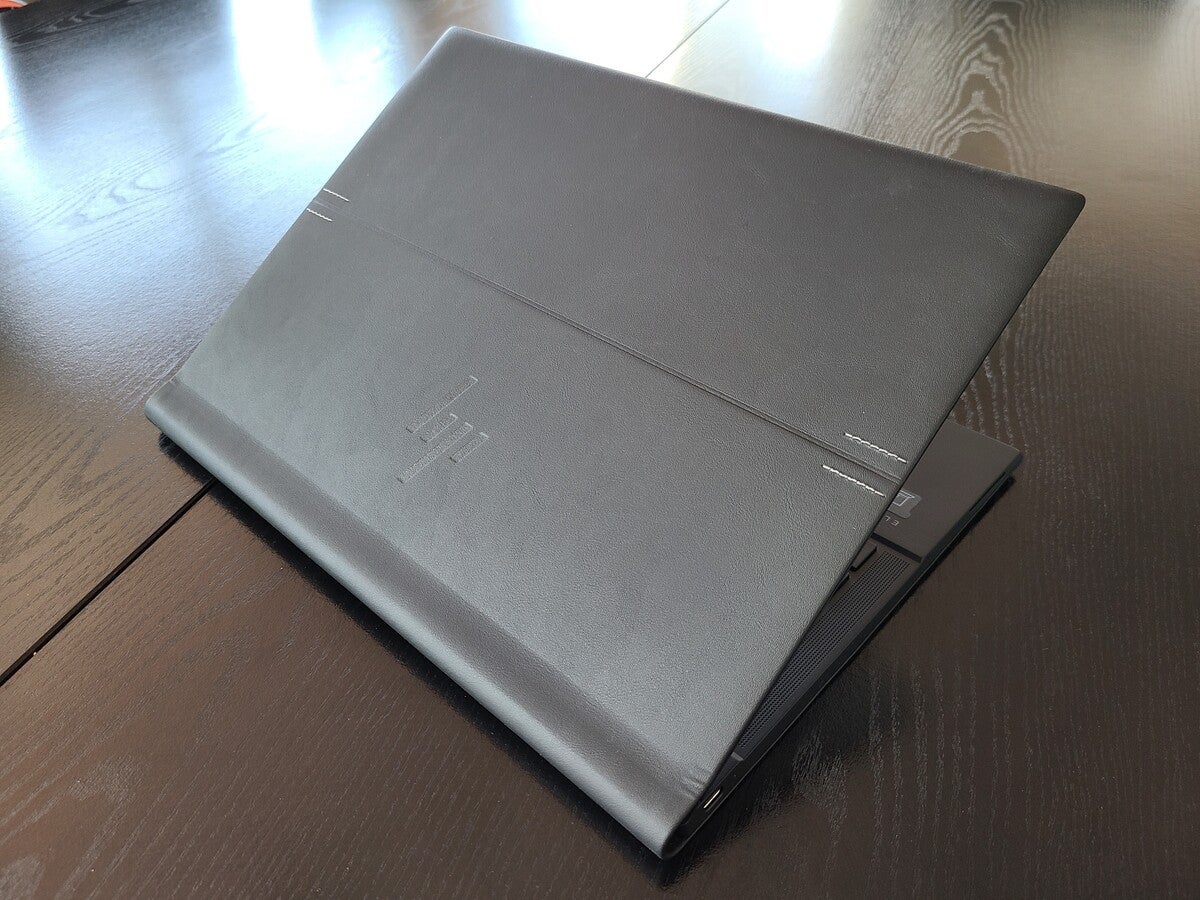 Mark Hachman / IDG
Mark Hachman / IDG“Vegan leather” wraps the outside surfaces of the HP Elite Folio.
These Arm chips come with trade-offs. Historically, they’ve run more slowly than an Intel Core or AMD Ryzen chip, in part because of the need to emulate traditional x86 instructions. That’s less of a concern now, as more applications can either run on native Arm code, or via the web. Just don’t expect to play games on the Elite Folio—it’s an optimized Office or web browsing machine first and foremost.
The Elite Folio may look a lot like the 2019 Spectre Folio. There’s one major external difference: Unlike the Spectre Folio’s real leather cladding, the Elite Folio is wrapped in “vegan leather,” which is just a fancy name for polyurethane. That material conveys a luxurious look while being animal-friendly. Inside, the keyboard deck returns to a more traditional, plasticky surface.
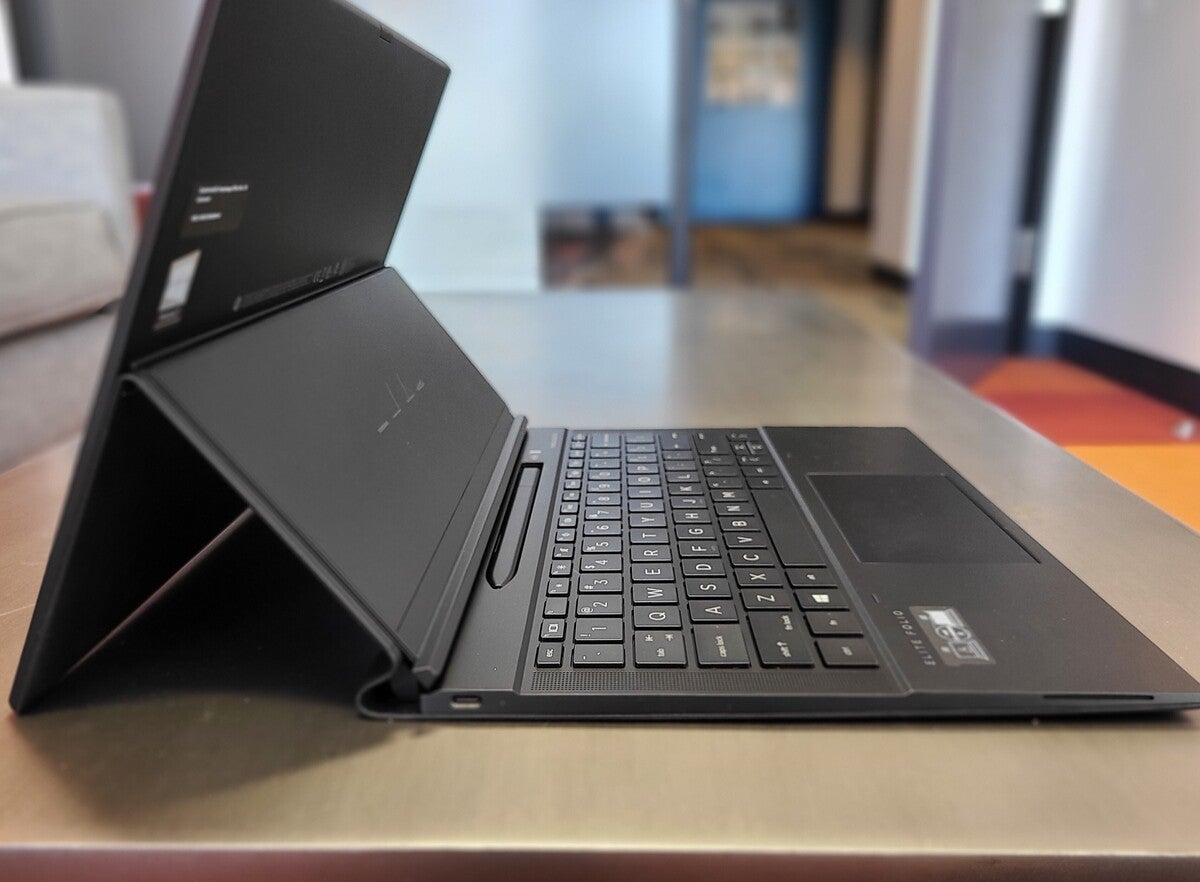 Mark Hachman / IDG
Mark Hachman / IDGThis unofficial “presentation” mode orientation shows how the Elite Folio straddles the definition of a detachable Windows tablet and a more traditional design.
The low-power Snapdragon chip allows the Folio to run completely without a fan. You can clearly feel the warmth that the CPU puts out at the bottom of the screen, though it never even approaches uncomfortable temperatures.
The HP Elite Folio’s display is pleasing: bright, with vivid colors that cover 99 percent of the SRGB color gamut, though only 74 percent of AdobeRGB and 75 percent of sRGB, as measured by our colorimeter. You might not buy a laptop to work outside, but if you do, the Elite Folio’s ready with two bright display options: a base model with a maximum 400 nits of brightness, and a 1,000-nit higher-end option, which we didn’t review. Turning up the display brightness will run down the integrated 46Wh battery more quickly, of course.
The Elite Folio includes built-in 4G LTE capabilities, with a SIM slot in the pen cubby, which we’ll talk about below. HP tells us there will be 5G options in the future.
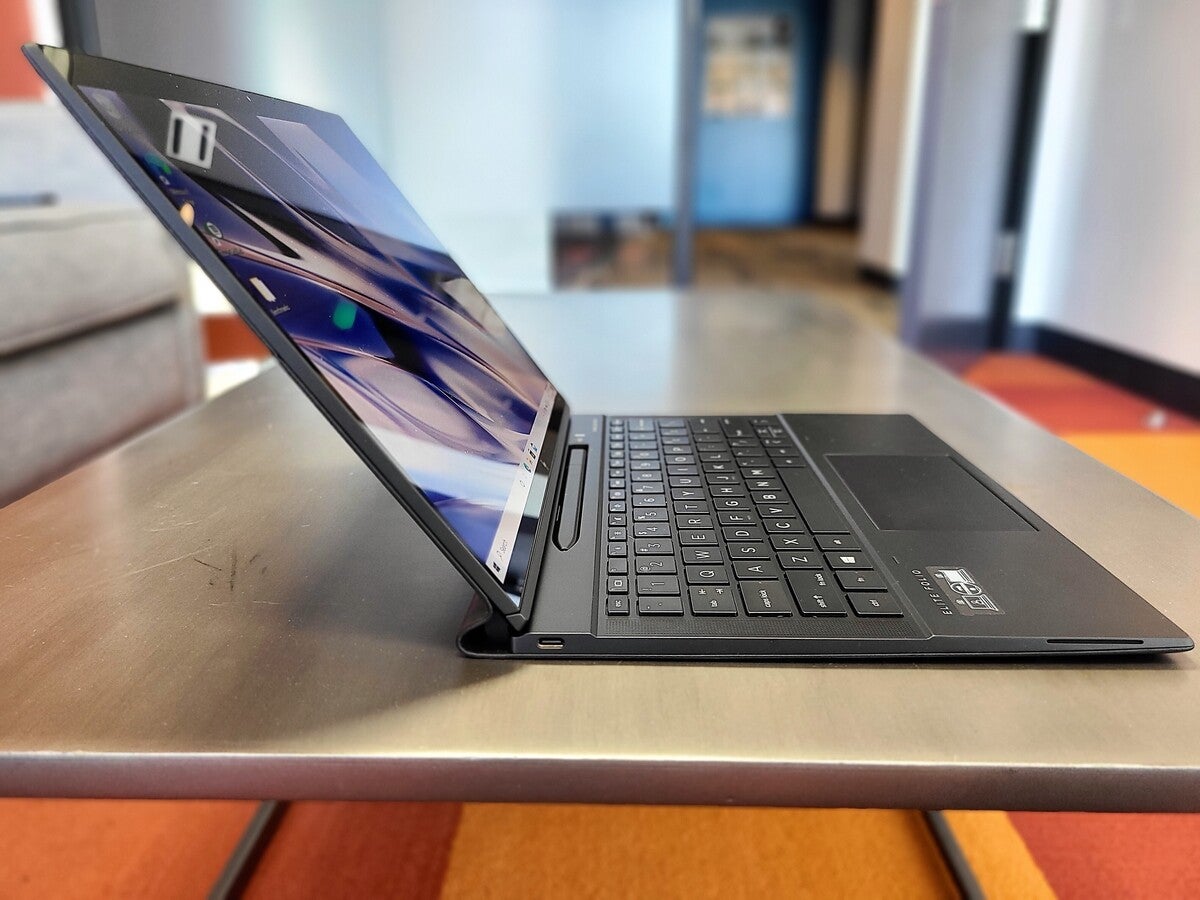 Mark Hachman / IDG
Mark Hachman / IDGA USB-C port lies on either side of the chassis.
Port selection is sparse—two USB-C (not Thunderbolt) connections, one on either side of the chassis. Connecting to a Thunderbolt dock enabled work on a single external 4K display, which satisfied our productivity needs.
Typing experience
HP offers some of the most comfortable keyboards in the industry—but not on the Elite Folio. Although its keys are almost aggressively springy, the shallow (1.3mm) travel is best suited for gentle tappers rather than forceful mashers. The layout is fairly standard, with a narrow row of function keys at the top and cross-shaped cursor keys to the lower right. The F2 key entirely lacks a secondary function, a rather unusual omission.
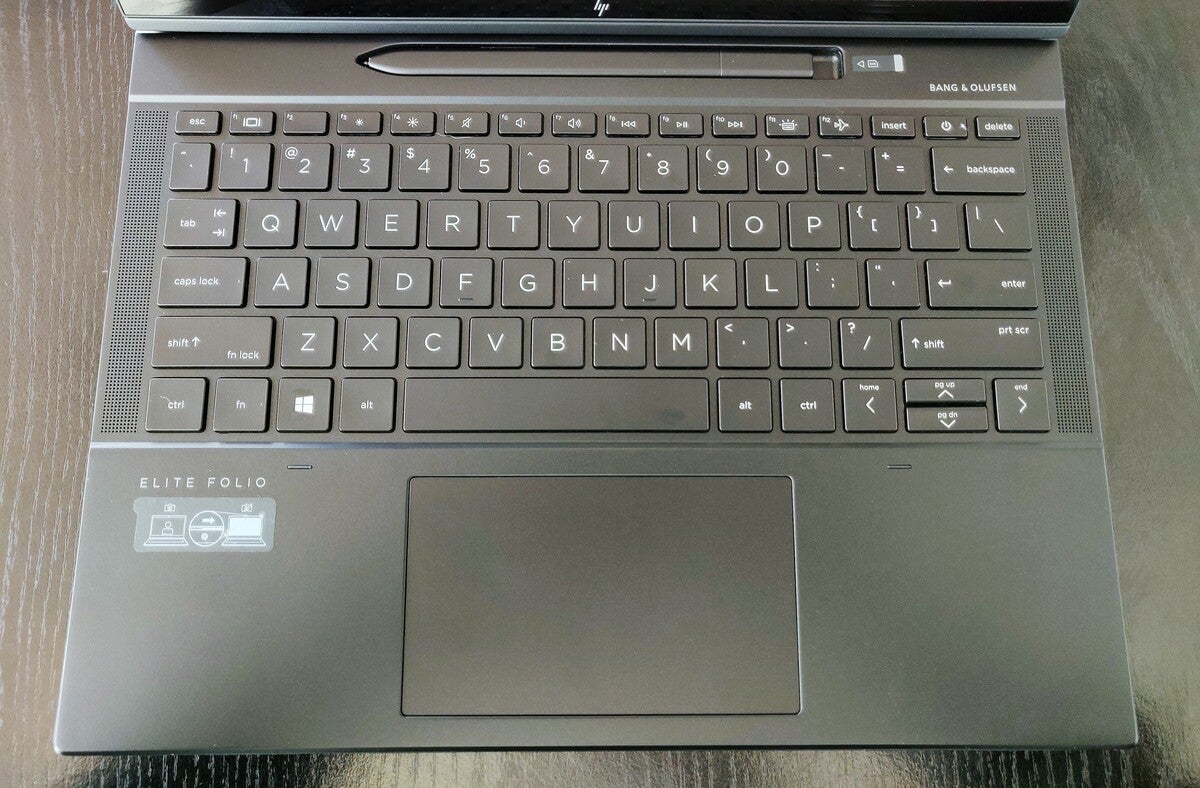 Mark Hachman / IDG
Mark Hachman / IDGThe HP Elite Folio keyboard offers shallow, though spacious keys.
The Elite Folio trackpad, while not overly large, boasts the glossy glass smoothness of a premium offering. Windows classifies it as a Precision touchpad, meaning that Microsoft and Windows can manage its drivers, add gestures, and improve it over time. It’s clickable almost all the way to the top.
HP’s Elite Folio includes a 720p webcam, mounted at the top of the PC’s display bezel, which offers average graininess and color balance. You do have to wonder whether, after over a year working from home, HP at least considered a more premium 1080p webcam option.
The Elite Folio offers a bit more in the sliding webcam shutter. Run your finger or thumb over a rough ridge of plastic at the top of the screen to opens and close the shutter manually. Rival Lenovo offers this in its ThinkPads and does a slightly better job by visually indicating that the shutter is closed with a tiny, red, opaque panel. HP uses a white dot with slashes through it, which is hard to differentiate from the open shutter.
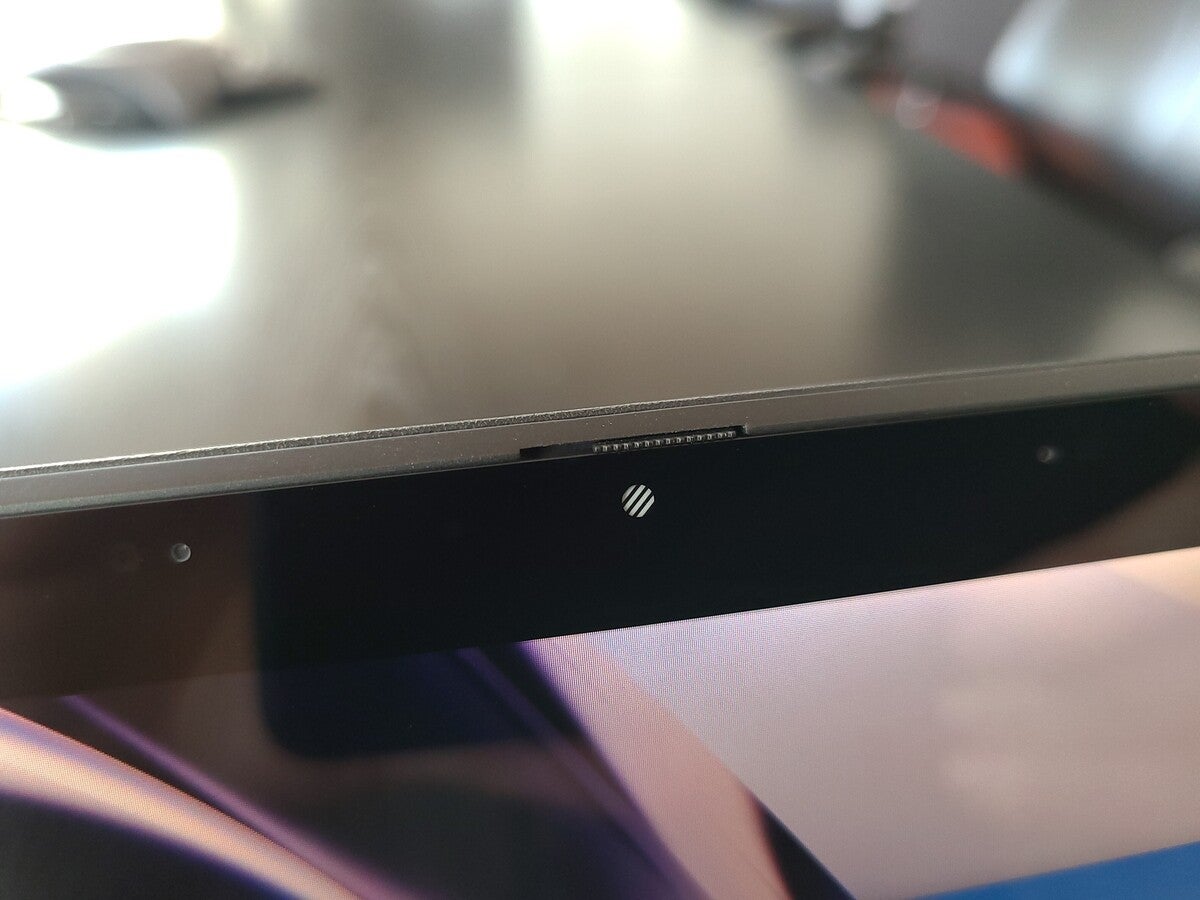 Mark Hachman / IDG
Mark Hachman / IDGThe sliding webcam shutter is a nice feature, though it’s a bit difficult to distinguish, at a distance, whether the webcam is open or closed.
The HP Elite Folio’s audio projects from a pair of speakers mounted in the palm rest area and upward-facing speakers midway up the keyboard, pumping out enough volume to fill a quiet to slightly noisy room. Tuned by Bang & Olufsen, the sound quality competently fills the midrange and high end, though the bass unsurprisingly lacks oomph. I couldn’t find any audio controls besides the Windows defaults.
One of the showcase features of the Elite Folio is the two-button, 5.5-inch Wacom AES 2.0 pen, which nestles in a cubby very much like the one in the Microsoft Surface Pro X—another Arm-powered device. Microsoft’s Surface Pro X conceals the pen cubby, but the Elite Folio’s is exposed, tempting you to use it.
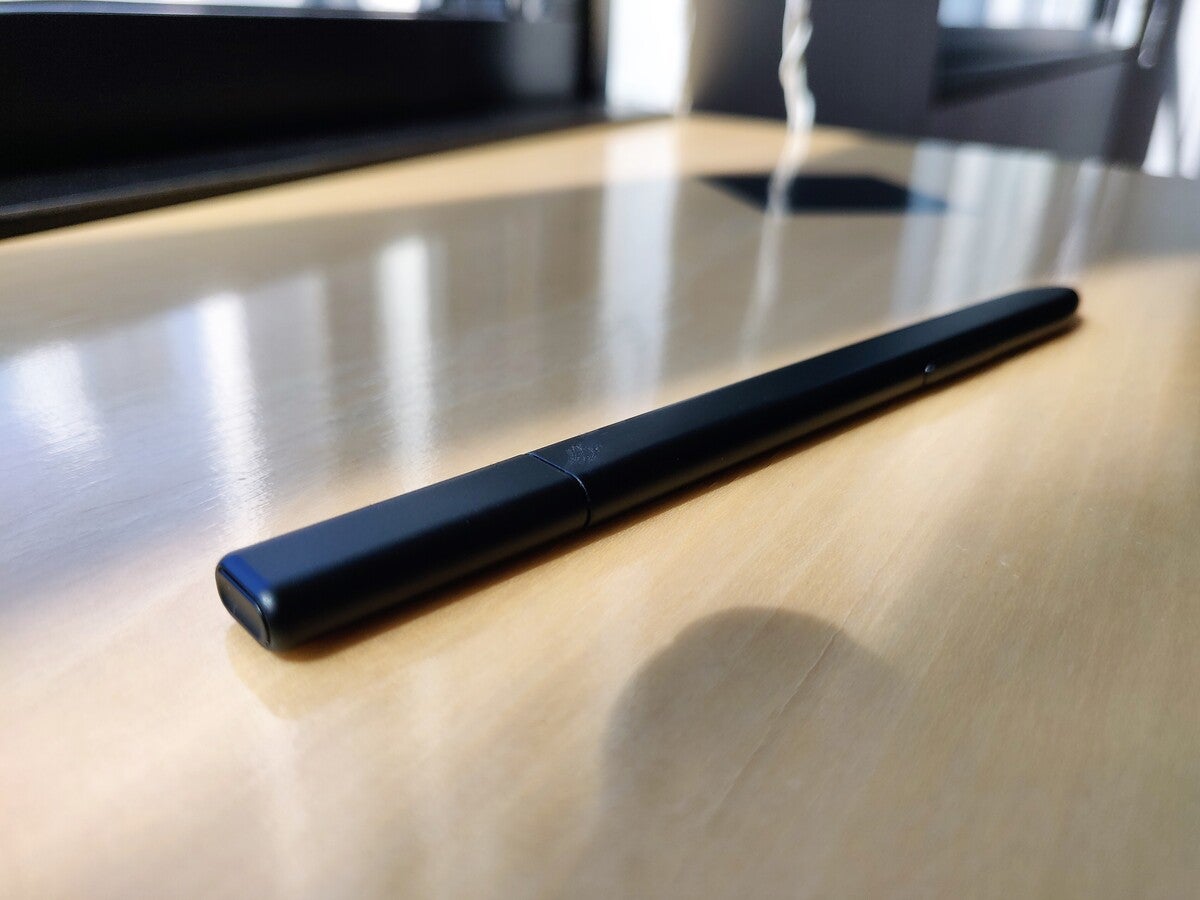 Mark Hachman / IDG
Mark Hachman / IDGThe Elite Folio Pen has a slightly recessed button at the end, and a more conventional button midway down.
Overall we prefer the inking experience in the Surface Pro X. The Surface Pen is a bit thicker and rounder, more comfortable to hold than the flattish Elite Folio pen. The Surface Pro X’s kickstand also offers more options for reclining the tablet. The HP pen’s end button is a bit too discreet: Because it sits flush with the end of the pen, it’s harder to depress. (There’s another button midway down the shaft.) There’s noticeable lag when inking with the pen. HP’s own configuration utility assigns both pen buttons optional functions.
On the plus side, the Folio’s pen offers built-in charging capabilities, which kick in when the pen is re-inserted in its cubby. Like the Surface Pro X, the magnetized cubby will automatically rotate the pen longitudinally to align the pen’s charging contacts with the cubby’s own. The pen’s charge lasted all day; it’s rated for 30 hours of use or ten days of standby, with a 30-minute recharge cycle. HP also uses the cubby to house the SIM tray.
How does the Elite Folio perform? Find out on the next page.
For all the latest Technology News Click Here
For the latest news and updates, follow us on Google News.
